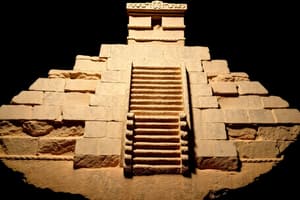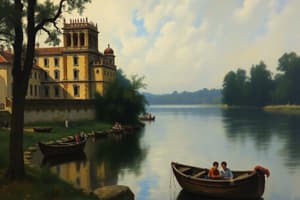Podcast
Questions and Answers
What method was suggested to find out about events that happened yesterday?
What method was suggested to find out about events that happened yesterday?
- Ask somebody who remembers (correct)
- Consult historical documents
- Read ancient texts
- Visit historical sites
Which of the following describes the early inhabitants along the banks of the Narmada River?
Which of the following describes the early inhabitants along the banks of the Narmada River?
- They were primarily farmers who cultivated crops.
- They were skilled gatherers and hunters. (correct)
- They were nomadic tribes who moved constantly.
- They were traders who focused on commerce.
About how many years ago did people begin to grow crops such as wheat and barley?
About how many years ago did people begin to grow crops such as wheat and barley?
- 8000 years ago (correct)
- 2000 years ago
- 10000 years ago
- 5000 years ago
Which type of activities were undertaken by the people living along the Narmada River?
Which type of activities were undertaken by the people living along the Narmada River?
What can we infer about the variety of lives described in the content?
What can we infer about the variety of lives described in the content?
Where are the Sulaiman and Kirthar hills located compared to the Narmada River?
Where are the Sulaiman and Kirthar hills located compared to the Narmada River?
Which of the following practices did people begin around 8000 years ago?
Which of the following practices did people begin around 8000 years ago?
What materials are mentioned as being used to make objects that can survive for a long time?
What materials are mentioned as being used to make objects that can survive for a long time?
How are historians similar to detectives in their work?
How are historians similar to detectives in their work?
What type of remains do archaeologists usually find to understand past diets?
What type of remains do archaeologists usually find to understand past diets?
Which source is least likely to be found frequently by archaeologists?
Which source is least likely to be found frequently by archaeologists?
Why is the term 'pasts' used in the title of the book?
Why is the term 'pasts' used in the title of the book?
What motivated people to travel in ancient times?
What motivated people to travel in ancient times?
How did the geographical features of the subcontinent affect travel?
How did the geographical features of the subcontinent affect travel?
Which of the following groups were involved in long-distance travel?
Which of the following groups were involved in long-distance travel?
What is one consequence of the movements of people across frontiers?
What is one consequence of the movements of people across frontiers?
What does the name 'India' derive from?
What does the name 'India' derive from?
What significant role did merchants play in ancient travel?
What significant role did merchants play in ancient travel?
Which natural features posed challenges to travelers in the subcontinent?
Which natural features posed challenges to travelers in the subcontinent?
Why did some individuals travel despite the risks involved?
Why did some individuals travel despite the risks involved?
What impact did the arrival of people from across frontiers have on the subcontinent?
What impact did the arrival of people from across frontiers have on the subcontinent?
What is one of the purposes of inscriptions on hard surfaces?
What is one of the purposes of inscriptions on hard surfaces?
Who primarily practiced the art of writing inscriptions?
Who primarily practiced the art of writing inscriptions?
What type of materials were inscriptions typically made on?
What type of materials were inscriptions typically made on?
What are scripts composed of?
What are scripts composed of?
Which two scripts were used in the mentioned inscription?
Which two scripts were used in the mentioned inscription?
What profession is responsible for studying inscriptions and related archaeological findings?
What profession is responsible for studying inscriptions and related archaeological findings?
What type of information might kings inscribe for public knowledge?
What type of information might kings inscribe for public knowledge?
What name was used for the group of people living in the northwest mentioned in the Rigveda?
What name was used for the group of people living in the northwest mentioned in the Rigveda?
What can be inferred about the durability of written records on hard surfaces?
What can be inferred about the durability of written records on hard surfaces?
What is a potential difficulty of writing inscriptions on hard surfaces?
What is a potential difficulty of writing inscriptions on hard surfaces?
What type of manuscripts were typically written on palm leaves?
What type of manuscripts were typically written on palm leaves?
Which language is known as the earliest composition dated to about 3500 years ago?
Which language is known as the earliest composition dated to about 3500 years ago?
Where was the mentioned inscription found?
Where was the mentioned inscription found?
What was often the reason for the deterioration of many historical manuscripts over the years?
What was often the reason for the deterioration of many historical manuscripts over the years?
In addition to religious texts, what type of subjects did many manuscripts cover?
In addition to religious texts, what type of subjects did many manuscripts cover?
The term 'manuscript' comes from which Latin word that means 'hand'?
The term 'manuscript' comes from which Latin word that means 'hand'?
What is the bark of the tree commonly used for writing manuscripts that grows in the Himalayas?
What is the bark of the tree commonly used for writing manuscripts that grows in the Himalayas?
Which language, aside from Sanskrit, was used by ordinary people for writing manuscripts?
Which language, aside from Sanskrit, was used by ordinary people for writing manuscripts?
What was a common location for the preservation of many ancient manuscripts?
What was a common location for the preservation of many ancient manuscripts?
What did the Iranians and Greeks refer to the river Indus as?
What did the Iranians and Greeks refer to the river Indus as?
Flashcards
Early human settlements
Early human settlements
Early humans lived along the Narmada river and later in areas near the Sulaiman and Kirthar hills.
Early food sources
Early food sources
Early humans gathered food from plants and hunted animals.
Agriculture's beginning
Agriculture's beginning
Around 8000 years ago, humans started growing crops like wheat and barley, and raising animals.
Historical records
Historical records
Signup and view all the flashcards
Early human lifestyles
Early human lifestyles
Signup and view all the flashcards
Finding out about the past
Finding out about the past
Signup and view all the flashcards
Archaeological studies
Archaeological studies
Signup and view all the flashcards
Early human travel
Early human travel
Signup and view all the flashcards
Barriers to travel
Barriers to travel
Signup and view all the flashcards
Cultural exchange
Cultural exchange
Signup and view all the flashcards
Names for India
Names for India
Signup and view all the flashcards
Movement of people
Movement of people
Signup and view all the flashcards
Difficult travel
Difficult travel
Signup and view all the flashcards
Natural Disasters
Natural Disasters
Signup and view all the flashcards
Merchants
Merchants
Signup and view all the flashcards
Religious Teachers
Religious Teachers
Signup and view all the flashcards
Indus River
Indus River
Signup and view all the flashcards
Bharata
Bharata
Signup and view all the flashcards
Manuscripts
Manuscripts
Signup and view all the flashcards
Palm Leaf Manuscripts
Palm Leaf Manuscripts
Signup and view all the flashcards
Birch Bark Manuscripts
Birch Bark Manuscripts
Signup and view all the flashcards
Preservation of Manuscripts
Preservation of Manuscripts
Signup and view all the flashcards
Subjects Covered in Manuscripts
Subjects Covered in Manuscripts
Signup and view all the flashcards
Languages of Ancient Texts
Languages of Ancient Texts
Signup and view all the flashcards
Inscriptions
Inscriptions
Signup and view all the flashcards
Studying the Past
Studying the Past
Signup and view all the flashcards
Archaeologist
Archaeologist
Signup and view all the flashcards
What makes inscriptions advantageous?
What makes inscriptions advantageous?
Signup and view all the flashcards
What are the difficulties of inscriptions?
What are the difficulties of inscriptions?
Signup and view all the flashcards
Scripts
Scripts
Signup and view all the flashcards
Languages
Languages
Signup and view all the flashcards
What is the purpose of studying artifacts?
What is the purpose of studying artifacts?
Signup and view all the flashcards
What is the purpose of excavating?
What is the purpose of excavating?
Signup and view all the flashcards
What are the different types of artifacts archaeologists study?
What are the different types of artifacts archaeologists study?
Signup and view all the flashcards
How do archaeologists use different sources to learn about the past?
How do archaeologists use different sources to learn about the past?
Signup and view all the flashcards
What are artifacts?
What are artifacts?
Signup and view all the flashcards
Why are some artifacts better preserved than others?
Why are some artifacts better preserved than others?
Signup and view all the flashcards
What do archaeologists study?
What do archaeologists study?
Signup and view all the flashcards
How do sources help historians?
How do sources help historians?
Signup and view all the flashcards
Why is 'pasts' plural?
Why is 'pasts' plural?
Signup and view all the flashcards
Study Notes
Chapter 1 Introduction: What, Where, How and When?
- Rasheeda, while reading the newspaper, wondered how people could know about events from a hundred years ago.
- People can discover past events through various sources—newspapers, television, radio, interviews, and personal recollections.
- The past can be examined by understanding what people ate, the clothes they wore, the types of houses they lived in, and more.
- This includes the lives of hunters, herders, farmers, rulers, merchants, priests, craftspeople, artists, musicians, scientists, and children's activities like games, stories, and songs.
- People have lived along the Narmada River for hundreds of thousands of years.
- Early inhabitants were gatherers, utilizing forest plants, fruits, roots, and hunted animals.
The Past: Finding Out
- Manuscripts are historical documents written by hand on materials like palm leaves or birch bark.
- Archaeological discoveries, such as buildings, sculptures, or artefacts, provide insight into past societies.
- Insects, time, or intentional destruction often damage or destroy documents or artefacts
- Archaeologists study various elements, including pottery, weapons, tools, and ornaments to learn about past cultures.
Names of the Land
- India is also known as Bharat.
- The name "India" originates from the Indus River, known as Sindhu in Sanskrit.
- Ancient Greeks and Iranians used the name "Indos" or "Hindos" for the Indus River valley.
Why Do People Travel?
- Natural barriers like hills, mountains, and seas historically influenced travel and population distribution.
- People travelled in search of livelihood, to trade, to escape natural disasters, or driven by a desire for adventure.
- Cultural exchange flourished due to migration and interaction.
What Do Dates Mean?
- Dates are typically expressed as a number of years after the birth of Jesus. This is referred to as the Common Era (CE), or sometimes Anno Domini (AD).
- Years before the birth of Jesus are numbered backward with the designation Before Christ (BC).
Studying That Suits You
Use AI to generate personalized quizzes and flashcards to suit your learning preferences.



